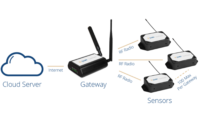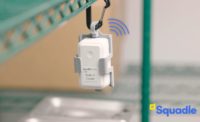Maria Ferrante
The Industrial “Internet of Things” is here, transforming the manufacturing floor as we know it. Just think how technology has changed our personal lives in just a few short years. Cell phones have gone from being used to make calls, to controlling our thermostats, home security systems and checking on our kids via webcam.
These same kinds of advances in connectivity, control and automation are now being applied to processing and packaging lines. The result of these Internet-enabled systems brings a new level of flexibility, performance and cost advantages, but also a layer of concern about data, plant information and product security.
Inside the IIoT
This Industrial Internet of Things (IIoT) is the network of physical objects-devices, machines, systems, computers and other items embedded with electronics, software, sensors and network connectivity that enables these objects to collect and exchange data. Often data is exchanged through the cloud, but some companies are utilizing corporate networks as an extra layer of protection.
“There is no doubt that the Internet of Things is becoming a must in current and future manufacturing operations in order to remain efficient and effective in an ever more competitive world,” says Richard Larsen, vice president, facilities & equipment, Honeyville, Inc. “These smart and necessary tools enable us to gather data, analyze that data and use the data to remain competitive.”
IIoT goes far beyond collecting data. “Data for the sake of data is useless. The Industrial Internet of Things leverages a digital thread, seamlessly connecting people, equipment, products, software. Currently, data is often found in isolation,” says Katie Moore, global industry manager, manufacturing, GE Digital. “IIoT is about getting connected, enabling us to use the data and insights to make smarter business decisions, driving efficiencies, product quality, and improving processes such as power and water usage.”
For this to be done effectively, machines need to be connected. But are processors and packagers ready for this change? According to a study conducted by research firm The MPI Group, manufacturers have incorporated smart devices or embedded intelligence in only 25 percent (median) of their production equipment and processes.
But this is quickly changing. The study predicts 76 percent of manufacturers will increase the use of smart devices or embedded intelligence in the next two years. The top five objectives for incorporating this technology are to improve product quality (58 percent); increase the speed of operations (57 percent); decrease manufacturing costs (57 percent); improve maintenance/uptime (47 percent); and improve information for business analytics (42 percent).
The importance of remote monitoring
One way equipment suppliers and their customers are using this technology is to remotely monitor equipment to diagnose problems quickly. “Service data shows that 70 to 80 percent of machine problems can be diagnosed and remediated remotely,” says Mark Ruberg, vice president, Pro Mach Business Process. “But the monitoring side is where we are really seeing the benefits. Data analytics provide real-time information that pinpoint problems before customers experience downtime.”
Taking a predictive maintenance approach can save customers time and money. “We work with component suppliers to monitor effectiveness and wear of individual machine components,” Ruberg added. “We can look at factors like the intensity of a photo eye, monitor air pressure, a pneumatic system’s total ‘health,’ stretch film usage/stretch, glue application, energy consumption of the motors/drives and more. For example, if there is dust build up on a light curtain we can send a signal to blow air on the light curtain to remove the dust bringing the light curtain’s performance back up to 100 percent.”
Despite the benefits, only a few manufacturers have the network infrastructure to accommodate IIoT machine-to-machine (e.g., sensors in one machine trigger actions of another machine) or machine to enterprise communications (i.e., machine sensors send data to corporate business systems), according to The MPI Group report.
This type of connectivity comes at a cost. “Cost justification remains a big issue with real operational data and objective results lacking to justify investment in IIoT systems. Food manufacturers operate with lean staffs and low margins and don’t have the inherent risks and downtime impact of other capital intensive industries,” says Roy Greengrass, P.E., corporate engineering, Del Monte Foods, Inc. “If the price for IIoT goes down considerably, food companies may then be able to justify these systems.”
But despite the cost, one key manufacturing metric that can be impacted by IIoT is Overall Equipment Effectiveness (OEE). One way manufacturers measure the availability, performance and quality of their manufacturing operation is calculating the OEE and then using that measure to improve processes. But collecting the data needed for OEE and doing the calculations has often been a tedious process.
“OEE is the best initial key performance indicator to look at; it is the gateway to optimizing your process. OEE is almost plug-in-play, you have the information at your fingertips,” Moore says.
Practical examples
At Del Monte, they are putting systems in place with remote monitoring of OEE in mind. “We have focused on connecting our packaging line machines via Ethernet data highways with existing PLCs to a cloud and plant-based system that monitors our downtime and operation from an OEE perspective,” Greengrass explains. “The data is available either locally or is accessible from any remote location. In addition, new sensors for our process are often ordered with an Ethernet connection to allow remote monitoring and future connectivity. Finally, our entire corporate data system is now cloud based.”
But measuring OEE is just the beginning. The true value of OEE comes from understanding the underlying losses: availability loss, performance loss, quality loss—and this is what IIoT can provide. “We are monitoring OEE with visual displays to reduce downtime and improve operating efficiencies. The benefit in pushing this information to those that need it is this allows issues to be addressed immediately. Data getting buried in monthly or weekly reports that does not allow immediate correction or root cause identification results in ongoing financial losses,” says Greengrass. “Improvements and early detection of quality defects, as well as better insights into the root cause of manufacturing issues, are major benefits. These improvements, as well as the reduction of machine failures and downtime, result in cost savings.”
To help manufacturers gain a better understanding of OEE and the various factors that can impact this key performance indicator, the OpX Leadership Network, a community of manufacturing, engineering and operations professionals convened by PMMI, The Association for Packaging and Processing Technologies, dedicated to operational excellence, released an OEE Starter Tool along with an OEE Benefits Calculator that calculates the product cost impact from your improvement efforts. “The OpX Leadership Network provides the OEE fundamentals from an industry perspective, and the calculator enables you to do the calculations. It really shows you the size of the prize. At GE, our technology digitized these industry accepted standards, making them easier to implement,” Moore says.
Pro Mach has also adopted the OpX Leadership Network tools. Customers report productivity gains simply with implementation of OEE measurement tools and reports. “Our ProTech System calculates OEE using the OpX Leadership Network’s industry standard,” Ruberg says. “Studies show that customers report five percent productivity gains just by implementing the system—just the fact that plant workers are aware that there are tools monitoring productivity.”
First steps
So how does one get started down the IIoT superhighway? “Start small. Look at your critical assets, or a critical line. Once you know things like if a piece of equipment is up or down, if it is running efficiently, you can look at why not and determine what is preventing it from doing so. Most importantly, business outcomes must be married with getting started with a data collection strategy,” Moore says.
And while large enterprise systems can be costly, you can begin the process on a much smaller scale. “You can get started simply. The key is getting visibility for a relatively nominal price; we are not talking about huge investments to start seeing improvements. We are talking about implementing software solutions to make systems more efficient; this is a way to maximize your capital investments,” Moore says.
But despite all the benefits, every discussion about IIoT begins with security. “Security with availability in mind,” says Rob Dargie, electrical engineer, Amway. “Industrial control networks are a target rich environment.”
“Security is always the first, second and third questions customer’s ask. We have handled that by putting our monitoring on a dedicated network, it is a completely different path,” Ruberg says.
While you need to consider the security of your systems, it is important to also consider the security of your suppliers’ systems as well. “The intent is efficiency, accuracy and availability in order for not only systems to operate securely but also to provide service from third-party vendors. The cyber security concern is with the connection from or to the internal systems. Not only internally connected but now utilizing the internet to communicate with outside cloud resources and services. Anything connected to the internet has a level of exposure,” says Mike Muscatell, information security manager, Snyder’s-Lance, Inc. “Another aspect to consider is, although the connection may be secured through encryption, if the vendor’s system has been compromised then that simply means the attacker has a secure connection back to their customer’s network.”
The availability of data in the cloud and on all types of devices increases risk. “Today’s exposure factors have increased due to demand for ease of use with mobile connectivity to information and systems. The question that should be asked is, what data is leaving and how?” Muscatell says.
But, according to Muscatell, what it really comes down to is a focus on cyber security awareness. “The same security solutions that protect the entire organization also protect the manufacturing environment but what is seriously lacking that I have seen in meeting with various partners and vendors is a lack of awareness. At the end of the day folks just want things to work but if they were provided with information on what to be more aware of in terms of cyber security, then related risks would potentially be reduced,” he says.
IIoT and FSMA
In addition to cyber security, food manufacturers have a heightened awareness around food safety with the Food Safety Modernization Act (FSMA) taking effect fall 2016, says Jeffrey Barach, Ph. D, FSMA expert and consultant for PMMI, The Association for Packaging and Processing Technologies.
IIoT will likely play an important role in ensuring food safety. “With FSMA, prevention of hazards is the key, and gathering data and monitoring processes is an important part of this equation,” Barach says.
“The type of real-time monitoring that comes with IIoT has significant advantages in food production over the type of intermittent monitoring traditionally found in food plants. It allows for quicker response, limiting the volume of product affected by any mishap. This type of monitoring can take human limitations out of the system,” Barach says.
With the implementation of FSMA, the FDA will rely heavily on data collection. “IIoT simplifies the data collection process,” Barach adds. “I see a significant potential for the data collection and remote monitoring capabilities to enhance food safety capabilities for food manufacturers.”
An eye on the future
According to PMMI’s Vision 2020 Report, attracting and retaining quality talent in manufacturing is far and away the greatest challenge facing manufacturing today. With the advent of IIoT, the skill set needed for manufacturing facilities may be changing. “Manufacturers will need to incorporate more mobile technology in the plant to accommodate a different skill set now coming into the workforce. IIoT is really about people, process and technology, people being the critical part of that equation,” Moore says.
The technology that IIoT brings to the plant floor can also be used in training. “IIoT can be a great training tool. If internet communication is available with download training material at the equipment location or if operator can go to OEM sites and receive training on operations, safety, service, etc., this would be a great tool,” Larsen says.
PMMI’s Certified Trainer program, a train-the-trainer program customized for manufacturing, fosters the partnership needed between machinery manufacturers and their customers. “Equipment reliability requires not only quality equipment, but also a well trained workforce. In order to effectively implement technology such as IIoT, the partnership between suppliers and customers is critical, and our program provides a framework for that communication and collaboration to happen,” says Stephan Girard, director, workforce development, PMMI.
As the industry strives to realize the full benefits of IIoT technologies, collaboration on all levels will be necessary. PMMI continues to serve as an industry resource, helping to move manufacturing forward to meet these challenges. By connecting people through networking communities, such as the OpX Leadership Network and at PACK EXPO trade shows, to providing critical information through industry research and education and workforce development programs, PMMI is uniquely positioned to assist manufacturers at all stages of their investigation and investment into the Industrial Internet of Things.
Maria Ferrante is senior director, marketing and communications, PMMI, The Association for Packaging and Processing Technologies. For more information, visit www.PMMI.org.




